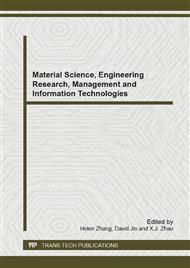p.247
p.253
p.259
p.264
p.270
p.274
p.279
p.285
p.290
Optimization of Coagulation Process for Disperse Navy Blue Dye Wastewater Treatment Using Response Surface Methodology
Abstract:
A response surface methodology (RSM) was used for the determination of optimum coagulation process conditions for disperse navy blue dye wastewater treatment. The experimental design was Box-Behnken design (BBD) with three operational variables: coagulant dosage, pH value and settling time. The influence of these three independent variables on the chroma removal was evaluated using a second-order polynomial multiple regression model. Quadratic model was predicted for the response variable and the maximum model-predicted chroma removal efficiency was 95%. Based on surface and contour plots, the optimum conditions were obtained to be coagulant dosage of 70.98 mg/L, pH value of 7.46, and settling time of 15.80 min with the actual chroma removal efficiency as 93%.
Info:
Periodical:
Pages:
270-273
Citation:
Online since:
June 2014
Authors:
Price:
Сopyright:
© 2014 Trans Tech Publications Ltd. All Rights Reserved
Share:
Citation:


